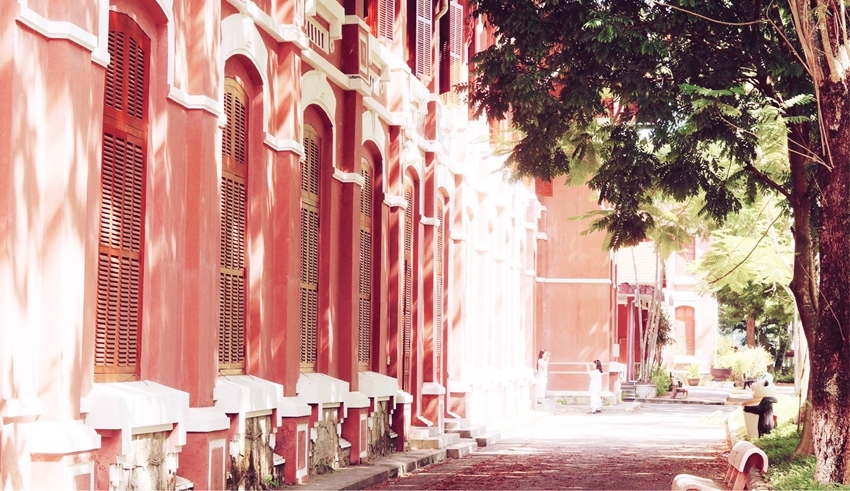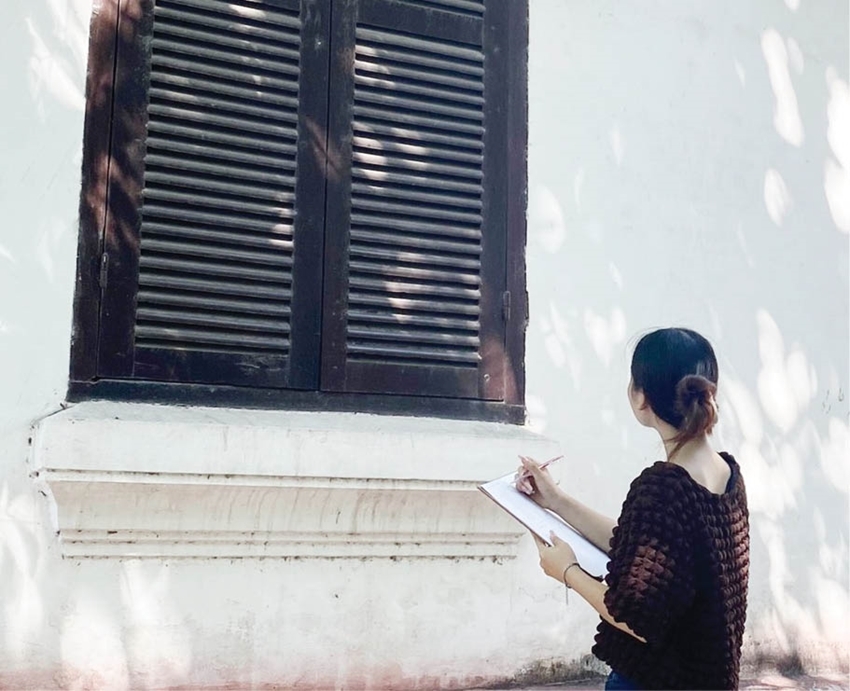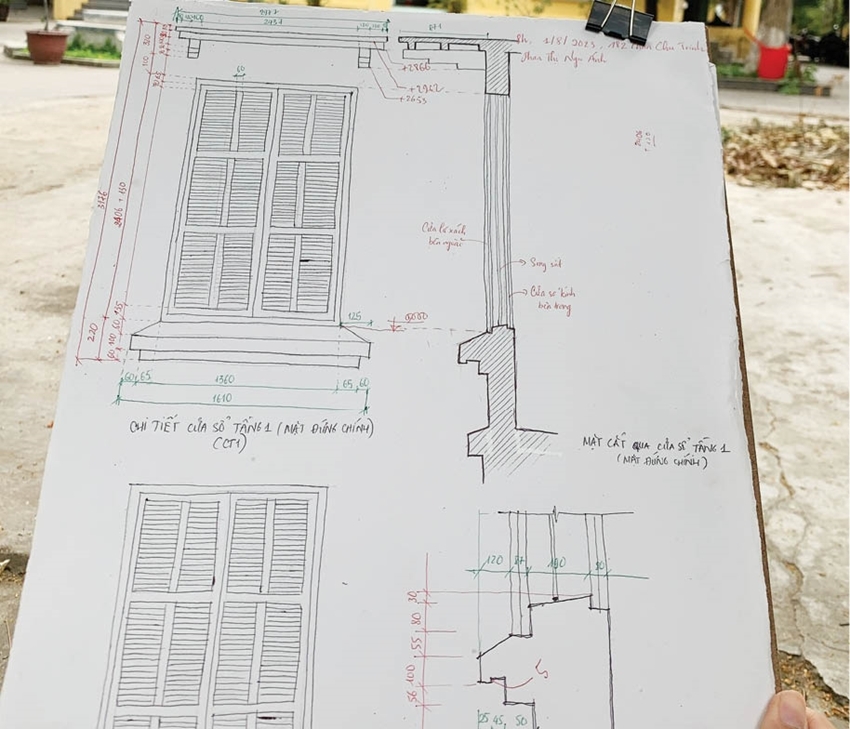 |
| Preserving French architecture in Hue is also preserving a piece of the city's cultural memory. Photo: Ngoc Anh - Tri Dung - Van Thanh |
Arousing passion
Over the past year, Le Loi Street has become familiar with the sight of a group of students, including Phan Thi Ngoc Anh, Huynh Ngo Tri Dung, and Hoang Van Thanh from the Faculty of Architecture, University of Sciences, Hue University. “We worked together to research, collect information, and support each other in measuring, sketching, and photographing buildings. Although it was hard work, thanks to our teamwork, we could divide the tasks and support each other during field surveys,” said Tri Dung.
 |
| Observing and redrawing architectural details |
Ngoc Anh recalled that before, she and her friends had only knew about French architecture in Hue through seminars organized by the faculty and the university. The opportunity came to her when she received an invitation from Dr. Nguyen Ngoc Tung, Architect, Head of the Faculty of Architecture, University of Sciences, Hue University to participate in supporting the measurement and drawing of French architecture for his research project. “The survey and drawing trips not only helped me understand more about the architectural values but also aroused my love for French architecture. That is why our group registered to conduct a scientific research project on French structures in Hue,” shared Ngoc Anh.
The most profound impression on the group was Quoc Hoc Hue High School for the Gifted, a symbol of neoclassical architecture located on Le Loi Street. Standing out with its red-pink color and surrounding lush greenery, Quoc Hoc is not only the school of many generations of students but also a vibrant part of Hue's history. The double-layer windows with canopies and specially designed doorsills prevent water from pooling and seeping into the walls, while the decorative motifs bear the strong imprint of Eastern art, etc., all of which are evidence of the ingenuity of the blended architecture, where Western beauty merges with distinctive features of the East.
 |
| Details of the buildings are shown in the drawings |
In the early days of the survey, the team usually chose sunny days for convenient measurements. However, during the rainy season, the entire group had to take shelter under the eaves of buildings many times. “Under the rain of Hue, the old French buildings seemed to come alive, as if carrying the memories of time. The rain created transparent streaks on the brick walls and tiled roofs, making the space seem dreamy and mysterious. The rustling sound of the rain, combined with the quietness of the streets, created a romantic and gentle beauty, making me feel like I was listening to the old stories of Hue,” recalled Ngoc Anh.
Sometimes, the group would become “accidental tour guides” when they encountered visitors. After a few questions, they would introduce and share the historical stories of the structures. For Van Thanh, these conversations not only made the work more interesting but also provided an opportunity to share his pride in Hue's heritage.
Cultural memory of the city
According to Dr. of Architect Nguyen Ngoc Tung, there are currently 55 French colonial-era structures in Hue City, designed in six distinct architectural styles, including: Neoclassical, Art Deco, Euro-Asian fusion, French local, Pre-colonial, and others. Preservation efforts not only are aimed at maintaining aesthetic value, but also contribute to protecting the special cultural assets of the heritage city.
Tran Minh Duc, architect, a member of Hue City Architects Association, affirmed: “Preserving French architecture in Hue is not merely about safeguarding buildings; it is about protecting a part of the city's cultural memory. These structures are not just Hue's assets, but also a shared heritage of humanity.” This further underscores the significance of studying and preserving French structures within the city, as they are not only architectural distinctiveness, but also “witnesses” to a period of turbulent history. Through every decorative detail, every moss-covered wall, one can feel the breath of time and the tales of cultural exchange.
“I believe that architectural buildings, in addition to contributing to the overall landscape of the city, also play a significant role in the historical process. These structures are like “witnesses” that have seen the ups and downs of this ancient capital. Whenever I step into a building, I wonder how it was constructed, what changes it witnessed in the city, and how people lived and worked here in the past. It sparks my curiosity and a desire to explore and preserve the values that have been passed down through the years,” shared Ngoc Anh.
For Tri Dung, the process of measuring and sketching not only helps to record the images of structures that are gradually deteriorating, but also creates a valuable source of data. “It is possible that one day, some of these structures will no longer exist, but there will still be drawings, images, designs, and research that have been preserved, contributing to the preservation and conservation of these cultural and architectural features in Hue,” said Tri Dung.
Hue's architectural structures all contain valuable cultural and historical values. Research will not only enrich the knowledge base of Hue's architecture, but also create opportunities to preserve and promote the value of these architectural structures. This is also the goal that Ngoc Anh is aiming for: “I hope to create a new perspective on Hue through the lens of architecture by preserving the cultural and artistic values of these structures, contributing to the preservation of Hue's rich and diverse architectural heritage, the heritage city.”